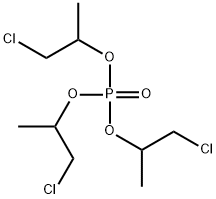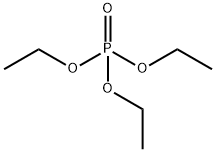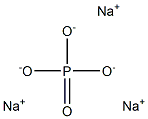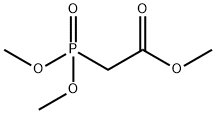Tris(1,3-dichloro-2-propyl)phosphate
Synonym(s):1,3-Dichloro-2-propanol phosphate;Phosphoric acid tris(1,3-dichloro-2-propyl ester);Tris(1,3-dichloro-2-propyl) phosphate
- CAS NO.:13674-87-8
- Empirical Formula: C9H15Cl6O4P
- Molecular Weight: 430.9
- MDL number: MFCD00083121
- EINECS: 237-159-2
- SAFETY DATA SHEET (SDS)
- Update Date: 2025-03-10 17:18:44

What is Tris(1,3-dichloro-2-propyl)phosphate?
Chemical properties
Tris(1,3-dichloro-2-propyl)phosphate is a clear colorless viscous liquid with a relatively low molecular weight, low water solubility, and low lipophilicity (as indicated by log Kow).
The Uses of Tris(1,3-dichloro-2-propyl)phosphate
Tris(1,3-dichloro-2-propyl)phosphate [TDCPP] is a halogenated phosphorus flame retardant used in a variety of sectors, including manufacturing of paints/coatings, furniture and related products, building/construction materials, fabrics/textiles/leather products, and foam seating and bedding products (EPA, 2012).
It is used extensively as an additive to flexible polyurethane foams (PUFs). Its end uses include molded automotive seating foam (e.g., seat cushions and headrests), slabstock foam in furniture, automotive fabric lining, and car roofing (ECHA, 2013). It is a high production volume chemical.
The Uses of Tris(1,3-dichloro-2-propyl)phosphate
Tris(1,3-dichloro-2-propyl) Phosphate is a flame retardant present in polyurethane foams.
What are the applications of Application
TDCPP is a flame retardant
Definition
ChEBI: Tris(1,3-dichloropropan-2-yl) phosphate is a trialkyl phosphate.
General Description
Clear colorless viscous liquid. Generally a super-cooled liquid at room temperature but may occasionally solidify when held at low temperatures for prolonged periods.
Air & Water Reactions
Insoluble in water.
Reactivity Profile
Fyrol FR 2 hydrolyzes slowly when refluxed with an aqueous acid. Under alkaline conditions, Fyrol FR 2 exhibits a slow cleavage. Fyrol FR 2 has plasticizing properties and, as such, may soften or deteriorate certain plastics and elastomers (particularly vinyl-based resin, neoprene and natural rubbers).
Fire Hazard
Fyrol FR 2 is combustible.
Safety Profile
Moderately toxic by ingestion. An experimental teratogen. Experimental reproductive effects. Questionable carcinogen with experimental carcinogenic data. Mutation data reported. When heated to decomposition it emits toxic fumes of Cland POx.
Environmental Fate
A series of studies have been performed to evaluate the environmental fate and bioaccumulation potential of Tris(1,3-dichloro-2-propyl)phosphate (TDCPP).EU concluded that TDCPP is expected to be persistent in water, sediment, sewage sludge, and soil. When emitted to the environment, the EU concluded that TDCPP will likely adsorb to particulate matter, based on its low volatility and relatively high adsorption coefficient. The Henry’s law constant suggests that TDCPP will preferentially partition to water, rather than air. When assessing TDCPP's potential for persistence or bioaccumulation, the EU determined that TDCPP can potentially be persistent or very persistent and that it does not meet the criteria for bioaccumulative or very bioaccumulative compounds.
Properties of Tris(1,3-dichloro-2-propyl)phosphate
| Melting point: | -64°C |
| Boiling point: | 315°C |
| Density | 1.512 |
| vapor pressure | 0Pa at 25℃ |
| refractive index | n20/D 1.503 |
| Flash point: | 249°C |
| storage temp. | Store at -20°C |
| solubility | Chloroform, Ethyl Acetate (Slightly), Methanol (Slightly) |
| form | solid |
| color | Colorless to Almost colorless |
| Specific Gravity | 1.518 (20/4℃) |
| Water Solubility | <0.1 g/100 mL at 24 ºC |
| Decomposition | 240-280 ºC |
| Merck | 14,9087 |
| Stability: | Stable. Reacts slowly with aqueous acids and alkalies. May soften plastics. |
| CAS DataBase Reference | 13674-87-8(CAS DataBase Reference) |
| NIST Chemistry Reference | Tris(1,3-dichloroisopropyl)phosphate(13674-87-8) |
| EPA Substance Registry System | Tris(1,3-dichloro-2-propyl)phosphate (13674-87-8) |
Safety information for Tris(1,3-dichloro-2-propyl)phosphate
| Signal word | Warning |
| Pictogram(s) |
 Health Hazard GHS08  Environment GHS09 |
| GHS Hazard Statements |
H351:Carcinogenicity H410:Hazardous to the aquatic environment, long-term hazard |
| Precautionary Statement Codes |
P202:Do not handle until all safety precautions have been read and understood. P273:Avoid release to the environment. P280:Wear protective gloves/protective clothing/eye protection/face protection. P391:Collect spillage. Hazardous to the aquatic environment P308+P313:IF exposed or concerned: Get medical advice/attention. P405:Store locked up. |
Computed Descriptors for Tris(1,3-dichloro-2-propyl)phosphate
| InChIKey | ASLWPAWFJZFCKF-UHFFFAOYSA-N |
New Products
3-Iodophenylacetic acid 3-Pyridineacetonitrile, α-hydroxy- 2-Propanamine, 1-chloro-, hydrochloride (9CI) 3-(hexyloxy)-4-(pyridin-3-yl)-1,2,5-thiadiazole 2-Hexyn-1-ol Dibenzo-18-crown-6 Nickel(II) perchlorate hexahydrate, 98% 4-Bromophenylacetonitrile, 95% 3-Bromo-4-fluoroaniline, 97% Sodium tetraborate decahydrate, 98% Palladium(II) acetate, trimer, Pd 99% 4-Bromo-2-chlorotoluene, 97% N N Dimethylformamide Dimethyl Acetal (Dmf Dma) 2,3-Dichloro Benzoyl Cyanide [Side Chain] Bis(2-Chloroethyl) Amine Hydrochloride L-Glutamic Acid Diethyl Ester Hydrochloride 5-(Difluoromethoxy)-2-Mercaptobenzimidazole 1-Ethyl-3-(3-Dimethylaminopropyl)-Carbodiimide Hydrochloride [EDC Hcl] 1,4-Napthoquinone Bromoiodomethane Sodium Bicarbonate Methylene Dichloride (MDC) Ethyl Acetate Indole-3-Carbinol (I3C)Related products of tetrahydrofuran








You may like
-
 Tris(1,3-dichloro-2-propyl) Phosphate CAS 13674-87-8View Details
Tris(1,3-dichloro-2-propyl) Phosphate CAS 13674-87-8View Details
13674-87-8 -
 Tris(1,3-dichloro-2-propyl)phosphate 97% (HPLC) CAS 13674-87-8View Details
Tris(1,3-dichloro-2-propyl)phosphate 97% (HPLC) CAS 13674-87-8View Details
13674-87-8 -
 TDCPP CAS 13674-87-8View Details
TDCPP CAS 13674-87-8View Details
13674-87-8 -
 17604-74-9 3-Pyridineacetonitrile, α-hydroxy- 98+View Details
17604-74-9 3-Pyridineacetonitrile, α-hydroxy- 98+View Details
17604-74-9 -
 Cyclohexane, (2-propynyloxy)- 67967-07-1 98+View Details
Cyclohexane, (2-propynyloxy)- 67967-07-1 98+View Details
67967-07-1 -
 2-Propanamine, 1-chloro-, hydrochloride (9CI) 98+View Details
2-Propanamine, 1-chloro-, hydrochloride (9CI) 98+View Details
5968-21-8 -
 3-Iodophenylacetic acid 1878-69-9 98+View Details
3-Iodophenylacetic acid 1878-69-9 98+View Details
1878-69-9 -
 132945-75-6 (S)-1-Boc-3-methanesulfonyloxy-pyrrolidine 98+View Details
132945-75-6 (S)-1-Boc-3-methanesulfonyloxy-pyrrolidine 98+View Details
132945-75-6
